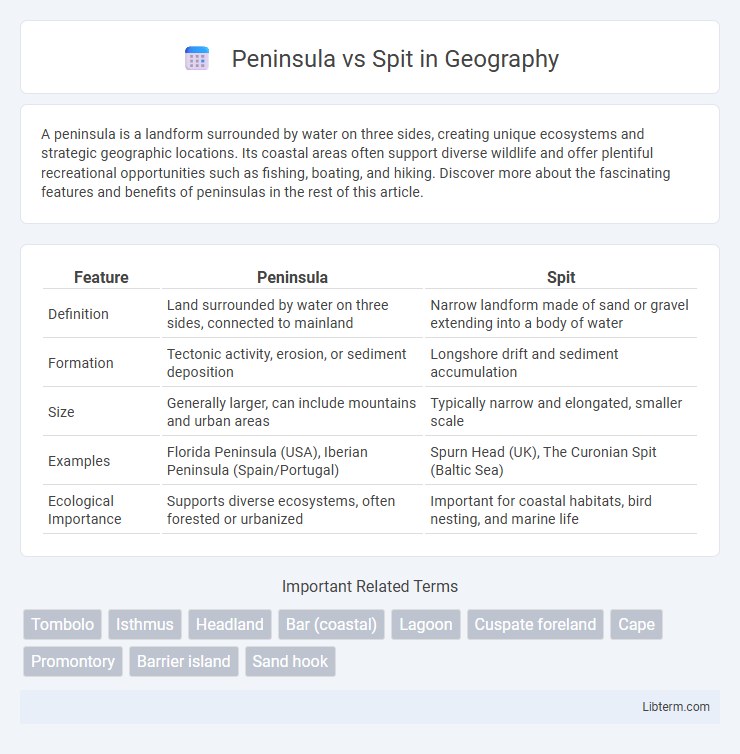A peninsula is a landform surrounded by water on three sides, creating unique ecosystems and strategic geographic locations. Its coastal areas often support diverse wildlife and offer plentiful recreational opportunities such as fishing, boating, and hiking. Discover more about the fascinating features and benefits of peninsulas in the rest of this article.
Table of Comparison
| Feature | Peninsula | Spit |
|---|---|---|
| Definition | Land surrounded by water on three sides, connected to mainland | Narrow landform made of sand or gravel extending into a body of water |
| Formation | Tectonic activity, erosion, or sediment deposition | Longshore drift and sediment accumulation |
| Size | Generally larger, can include mountains and urban areas | Typically narrow and elongated, smaller scale |
| Examples | Florida Peninsula (USA), Iberian Peninsula (Spain/Portugal) | Spurn Head (UK), The Curonian Spit (Baltic Sea) |
| Ecological Importance | Supports diverse ecosystems, often forested or urbanized | Important for coastal habitats, bird nesting, and marine life |
Peninsula vs Spit: Defining the Landforms
A peninsula is a landform surrounded by water on three sides but connected to the mainland, while a spit is a narrow, elongated landform extending from the coast into a body of water, formed primarily by sediment deposition. Peninsulas are typically larger and can support diverse ecosystems and human settlements, whereas spits are often smaller, dynamic structures shaped by longshore drift. Understanding the differences between peninsulas and spits is crucial for coastal management and geographical studies.
Key Geological Differences
A peninsula is a landform surrounded by water on three sides while connected to a mainland, typically formed by tectonic activity or sediment deposits. A spit is a narrow, elongated accumulation of sand or gravel projecting from the coast into the water, created primarily by longshore drift and wave action. The key geological difference lies in their formation processes: peninsulas result from broader geological forces shaping landmasses, whereas spits develop through sedimentary processes influenced by coastal currents.
Formation Processes Explained
A peninsula forms through processes such as tectonic activity, volcanic eruptions, or sediment deposition that extend landforms into a body of water, creating a large landmass surrounded by water on three sides. In contrast, a spit develops primarily from longshore drift, where sediment transported by waves accumulates to form a narrow, elongated landform projecting from the coast into open water. Both features result from sediment dynamics and coastal geomorphology but differ in scale and formation mechanisms.
Examples of Famous Peninsulas
Famous peninsulas include the Iberian Peninsula, home to Spain and Portugal, and the Scandinavian Peninsula, comprising Norway and Sweden, both known for their extensive coastlines and unique ecosystems. The Arabian Peninsula, the largest in the world, is crucial for its vast deserts and significant oil reserves, while the Florida Peninsula in the United States is recognized for its subtropical climate and biodiversity. These peninsulas differ from spits as they are larger landforms connected to the mainland on one side, extending prominently into surrounding bodies of water.
Notable Spits Around the World
Notable spits around the world include the Curonian Spit between Lithuania and Russia, known for its unique sand dunes and rich biodiversity, and the Spit of land at Cape Cod in Massachusetts, famous for its distinctive hook shape formed by longshore drift. Another significant example is the Arabat Spit in Ukraine, which serves as a natural barrier between the Sea of Azov and the Syvash lagoon. These spits play critical roles in coastal ecosystems and act as natural protection against storm surges, differentiating them from peninsulas, which are larger landforms connected more broadly to the mainland.
Ecological Significance of Peninsulas
Peninsulas serve as critical ecological zones offering diverse habitats that support unique flora and fauna due to their extended landform surrounded by water on three sides. These landforms contribute to biodiversity hotspots by creating microclimates and fostering rich marine and terrestrial ecosystems. The ecological significance of peninsulas includes acting as natural buffers against coastal erosion and providing essential breeding and nesting grounds for various endangered species.
Environmental Importance of Spits
Spits serve as critical natural buffers protecting coastlines from erosion by dissipating wave energy and stabilizing sediment deposits. These formations create unique habitats that support diverse flora and fauna, fostering biodiversity and serving as essential breeding grounds for migratory birds. The ecological functions of spits contribute to the resilience of coastal ecosystems, mitigating the impact of storms and rising sea levels.
Human Activities and Impact
Human activities on peninsulas often include urban development, tourism, and fishing, leading to habitat fragmentation and pollution that affect coastal ecosystems. Spits, frequently used for recreational purposes and as natural barriers protecting harbors, face erosion and sediment displacement intensified by construction and boat traffic. Both landforms experience ecological stress from human-induced changes, necessitating sustainable management to preserve biodiversity and shoreline stability.
Navigational and Economic Roles
A peninsula, projecting prominently into a body of water, often serves as a strategic location for major ports facilitating international trade and naval navigation, boosting regional economies through shipping and tourism. In contrast, a spit, formed by sediment deposition along coastlines, typically influences local navigation by altering tidal flows and providing sheltered areas for fishing boats and small harbors, supporting localized economic activities. Both landforms contribute to maritime infrastructure, but peninsulas tend to host larger commercial operations while spits mainly aid in coastal protection and small-scale economic uses.
Summary: Choosing the Right Term
A peninsula is a landform surrounded by water on three sides, connected to the mainland, while a spit is a narrow strip of sand or gravel extending from the shore into the water, formed by sediment deposition. Selecting between peninsula and spit depends on factors like size, formation process, and permanence; peninsulas are larger and more stable, whereas spits are typically smaller and dynamic. Correct usage enhances geographic accuracy in coastal descriptions and environmental studies.
Peninsula Infographic

 libterm.com
libterm.com